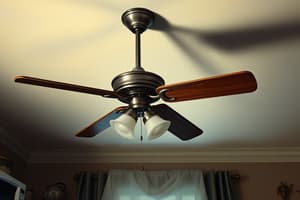Podcast
Questions and Answers
What is often the first step in troubleshooting lighting issues?
What is often the first step in troubleshooting lighting issues?
- Check the lighting schedule
- Ensure that all cables are plugged in (correct)
- Examine the DMX control cables
- Inspect the instrument mode settings
What type of report can be downloaded to check patching entry errors?
What type of report can be downloaded to check patching entry errors?
- Cue report
- Instrument schedule
- Error report
- Patching report (correct)
An experienced crew member is not necessary for troubleshooting lighting problems.
An experienced crew member is not necessary for troubleshooting lighting problems.
False (B)
Patching errors cannot be detected by error messages from the console.
Patching errors cannot be detected by error messages from the console.
What should be checked if one or two instruments are not functioning properly?
What should be checked if one or two instruments are not functioning properly?
Who should be included in discussions for backup alternatives in case of a significant lighting malfunction?
Who should be included in discussions for backup alternatives in case of a significant lighting malfunction?
Data entry into the computer assisted lighting control desk can include ______.
Data entry into the computer assisted lighting control desk can include ______.
Health and safety procedures are documented for serious _______ arising during performances.
Health and safety procedures are documented for serious _______ arising during performances.
Match the troubleshooting steps with their corresponding actions:
Match the troubleshooting steps with their corresponding actions:
What mode setting is a potential source of problems if it is set incorrectly?
What mode setting is a potential source of problems if it is set incorrectly?
Match the lighting system problems with their solutions:
Match the lighting system problems with their solutions:
Once IP addresses are established on a dedicated PC, they are likely to be a problem in the future.
Once IP addresses are established on a dedicated PC, they are likely to be a problem in the future.
What may be necessary to ensure the safety of the performance if problems occur?
What may be necessary to ensure the safety of the performance if problems occur?
Name one reason why lights may not be functioning properly.
Name one reason why lights may not be functioning properly.
Major problems with the lighting system can always be resolved quickly.
Major problems with the lighting system can always be resolved quickly.
Name one potential hazard that may need to be documented in health and safety procedures.
Name one potential hazard that may need to be documented in health and safety procedures.
Without a dedicated IP address, there can be communication problems between the PC and the ______.
Without a dedicated IP address, there can be communication problems between the PC and the ______.
If a problem arises during a performance, a _______ plan may need to be activated.
If a problem arises during a performance, a _______ plan may need to be activated.
Which of these is NOT a data entry activity on a computer assisted lighting control desk?
Which of these is NOT a data entry activity on a computer assisted lighting control desk?
What is a key action to take when encountering a lighting issue?
What is a key action to take when encountering a lighting issue?
Flashcards are hidden until you start studying
Study Notes
Troubleshooting Lighting Issues
- Essential resources for troubleshooting include user manuals and experienced crew members.
- Common causes of lighting malfunctions often relate to improperly plugged cables, including DMX control and power cables.
- Checking instrument bulbs is crucial if only a couple of instruments fail to work.
- Swapping DMX and power cables can help identify faulty connections.
- Ensure proper patching by comparing instrument schedules to dimmer circuits for any mismatches.
- Verify instrument mode settings against manufacturer manuals; incorrect modes may lead to functionality issues.
Data Entry and Computer Systems
- Data entry at the computer-assisted lighting control desk includes patching, cue groups, preset modes, and IP addresses.
- High-end consoles integrate the computer, reducing IP address issues unless external devices are involved.
- Changing dedicated PCs may create IP address communication problems between the console and the PC.
- Patching and cue reports can be compared to instrument schedules and cue sheets to identify errors.
- Digital consoles can display error messages for invalid entries, assisting operators in troubleshooting.
Addressing Major Problems
- Simple troubleshooting techniques can often resolve lighting issues; referring to manuals may provide further guidance.
- Consult with stage management and electricians during performances to formulate contingency plans for serious failures.
- Health and safety of the cast, crew, and audience must be prioritized during emergencies, such as electrical faults or mounting failures.
- Documentation of health and safety procedures should outline responses to serious hazards and designate responsible personnel.
Reacting to Significant Malfunctions
- In the event of unresolved major malfunctions, the lighting operator must collaborate with stage management, including the head electrician, stage manager, and lighting designer.
- Backup solutions may include uploading software, reconfiguring systems, or swapping dimmers/instruments.
- Extensive re-cabling might be necessary for system restoration.
- Backup options may incur expenses, such as equipment purchases or rentals; budget approval is necessary before incurring costs.
Studying That Suits You
Use AI to generate personalized quizzes and flashcards to suit your learning preferences.




